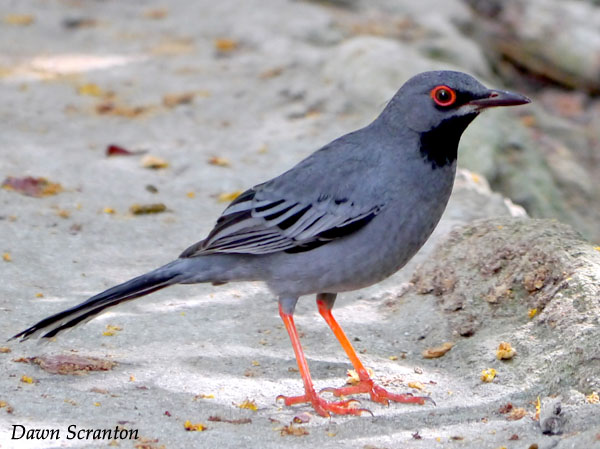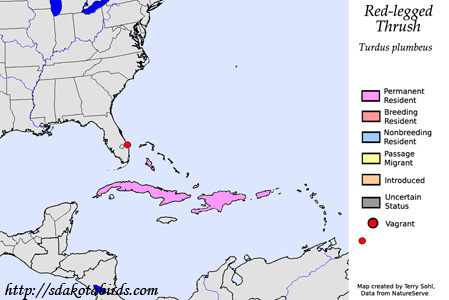| Length: 10.5 inches | Wingspan: 16 inches | Seasonality: Non-resident in South Dakota |
| ID Keys: Slate-grey body and wings, red eyering and legs, male's bill is black during breeding season, red otherwise. Belly and throat colors vary by location. | ||
 The
Red-legged Thrush is a songbird species of the Caribbean, with populations
in Cuba, Puerto Rico, the Bahamas, the Dominican Republic, Haiti, and
scattered other locations. Despite the close proximity of breeding
populations in the Bahamas, the species was unknown in the United States
until 2010, when a single bird was sighted on the Atlantic coast of eastern
Florida. In some areas they are common around human settlements, and are
sometimes considered the Caribbean equivalent of the
American Robin.
The
Red-legged Thrush is a songbird species of the Caribbean, with populations
in Cuba, Puerto Rico, the Bahamas, the Dominican Republic, Haiti, and
scattered other locations. Despite the close proximity of breeding
populations in the Bahamas, the species was unknown in the United States
until 2010, when a single bird was sighted on the Atlantic coast of eastern
Florida. In some areas they are common around human settlements, and are
sometimes considered the Caribbean equivalent of the
American Robin.
Habitat: Found in tropical and subtropical forested areas on islands of the Caribbean, including managed or disturbed land with trees, such as agricultural plantations or vegetated suburban areas. They prefer areas with tall trees and areas of dense undergrowth.
Diet: Omnivorous, feeding on a variety of food items. They will often feed on insects and other small invertebrates such as snails or worms. They also feed on fruits and berries. Other less common food items include vertebrates such as small lizards or frogs, and the eggs and young of other birds.
Behavior: Much of the foraging of a Red-legged Thrush is done by walking along the forest floor. They are strong fliers, but typically prefer to walk or run rather than fly. They may also forage well up in the forest canopy, particularly when after fruits and berries. They are crepuscular, with most foraging activity occurring near dawn or dusk. They are usually somewhat shy, skulking about near thickets or other protective cover. Not gregarious as some other thrush species, they are typically found alone or in pairs.
Nesting: The nest is place on the branch or fork of a tree, usually well off the ground (at least 20 feet, and often much higher in a tall palm or other tree). The nest is primarily built of grasses and other plant fiber, lined with small rootlets or other fine material. The female lays between 2 and 4 eggs. The young hatch after about 12 days, and fledge about 12 days after hatching.
Song: The song is a series of musical but monotonous repeated phrases of 1 to 4 syllables.
Migration: Considered permanent residents throughout their normal range.
Feeders: They have occasionally attended feeders for offered fruits.
Interactive eBird map: Click here to access an interactive eBird map of Red-legged Thrush sightings
Similar Species: Generally distinctive if seen well.
Conservation Status: Red-legged Thrush have a number of distinct populations across several islands in the Caribbean, and they are quite common in many of these locations. Populations overall appear to be stable. The IUCN lists the Red-legged Thrush as a species of "Least Concern".
Further Information: 1) Cornell's NeoTropical Birds - Red-legged Thrush
2) BirdLife International - Red-legged Thrush
3) BirdGuides - Red-legged Thrush
Photo Information: Photo by Dawn Scranton - January 14th, 2013 - Cayman Islands - Photo licensed under Creative Commons Attribution 2.0 Generic license.
| Click below for a higher-resolution map |
 |
| South Dakota Status: Non-resident in South Dakota |
Additional Red-legged Thrush Photos (coming soon!!)
